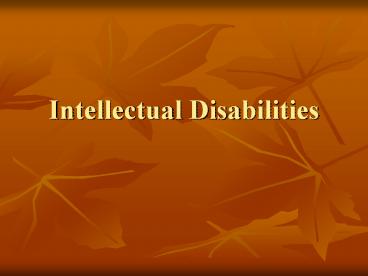Intellectual Disabilities PowerPoint PPT Presentation
1 / 10
Title: Intellectual Disabilities
1
Intellectual Disabilities
2
IDEA Categories
- Specific learning disabilities
- Emotional disturbance
- MENTAL RETARDATION (terminology changed)
- Autism
- Other health impairments
- Orthopedic impairments
- Traumatic brain injury
- Speech or language impairments
- Hearing impairments
- Visual impairments
3
Intellectual disability
- Intellectual disability is characterized by
significant limitations both in intellectual
functioning and in adaptive behavior as expressed
in conceptual, social, and practical adaptive
skills. This disability originates before age
18. (AAIDD, 2010)
4
an alternative definition . . .
- Mental retardation refers to a level of
functioning which requires from society
significantly above average training procedures
and superior assets in adaptive behavior on the
part of society, manifested throughout the life
of both society and the individual - Marc Gold, (1980)
5
Definition
- 5 assumptions exxential to the application of the
2010 AAIDD definition - 1. Limitations in present functioning must be
considered within the contest of community
environments typical of the individuals age
peers and culture - 2.Valid assessment considers cultural and
linguistic diversity as well as differences in
communication, sensory, motor, and behavioral
factors. - 3. Within an indiviudal, limitations often
coexist with strengths. - 4. An important purpose of describing limitations
is to develop a profile of needed supports - 5. With appropriate personalized supports over a
sustained period, the life functioning of the
person with intellectual disability will
generally improve
6
Definition and Components
- Intellectual disability
- Measured by IQ tests and adaptive behavioral
assessments - Calls for adaptations and/or special services
- May include some physical disabilities
- Can vary from state to state
- Manifests before age 18
- 1.4 of population
7
Use of Intelligence Testing
- In the past, over-representation of immigrant and
minority children - Tested primarily in English
- Adaptive behavior component not considered
- Concept of cultural fairness
- Only one component of identification
- Mild intellectual disability usually includes
children whose scores are between 50 and 75
8
Possible Causes ofIntellectual disability
- Organic
- Drugs
- Infections
- Genetics
- Environmental
- Toxins
- Diet
- Health
- Deprivation
9
Best Practices
- Demonstrate rather than tell
- Provide numerous opportunities for practice
- Use direct instruction
- Plan for high levels of task involvement
- Ignore insignificant errors
- Relate assignments to lessons
- Integrate subject matter (thematic)
- Take data
- Practice for tests and high stakes assessments
10
For those with more severe forms
- Issues
- Chronologically age appropriate skills
- Functional skills
- Teach in natural environments
- Integration vs. inclusion vs. mainstreaming vs.
full inclusion - Social skills
- Strategies
- Discrete trial training
- Prompting heirarchies
- Data based instruction
- Task analysis
- Top-down curriculum
- Outcomes
- Independent living
- Supported employment
- Community integration

